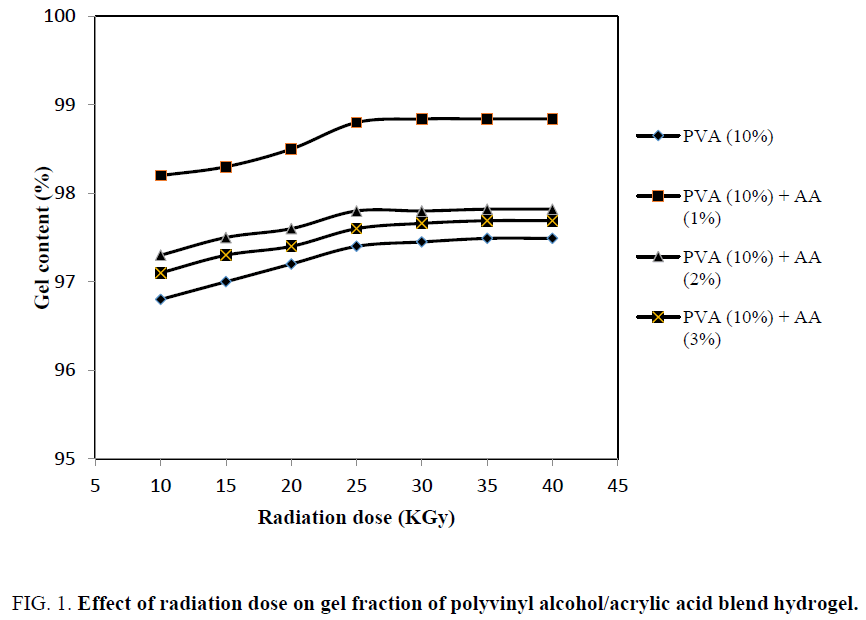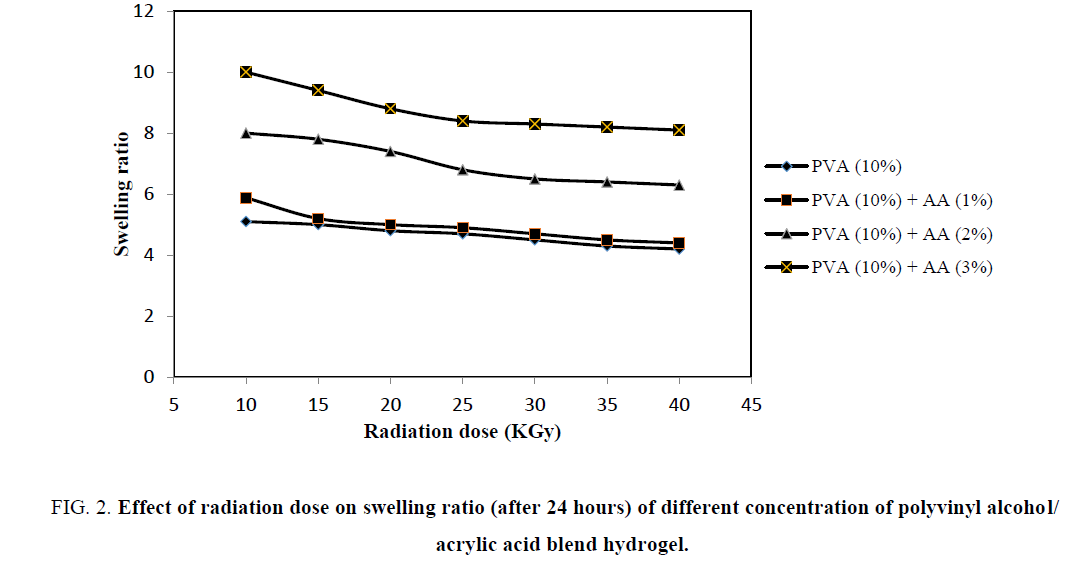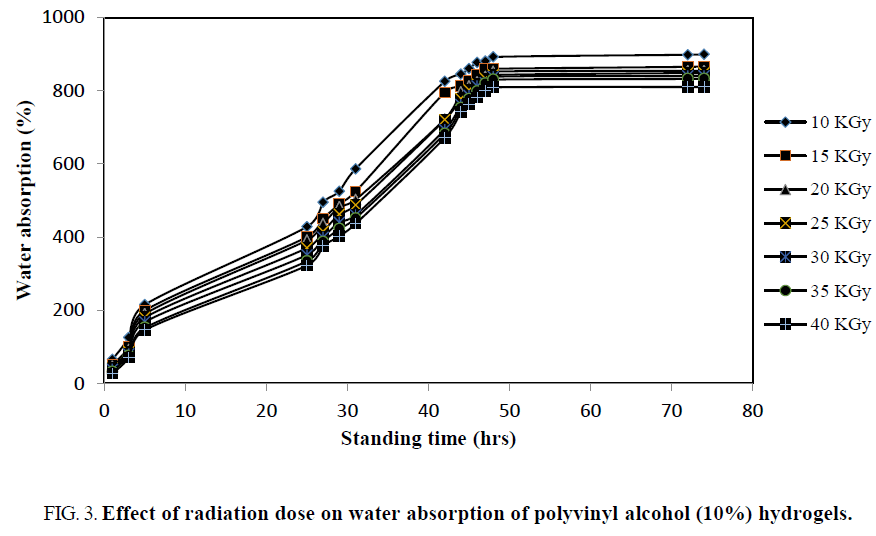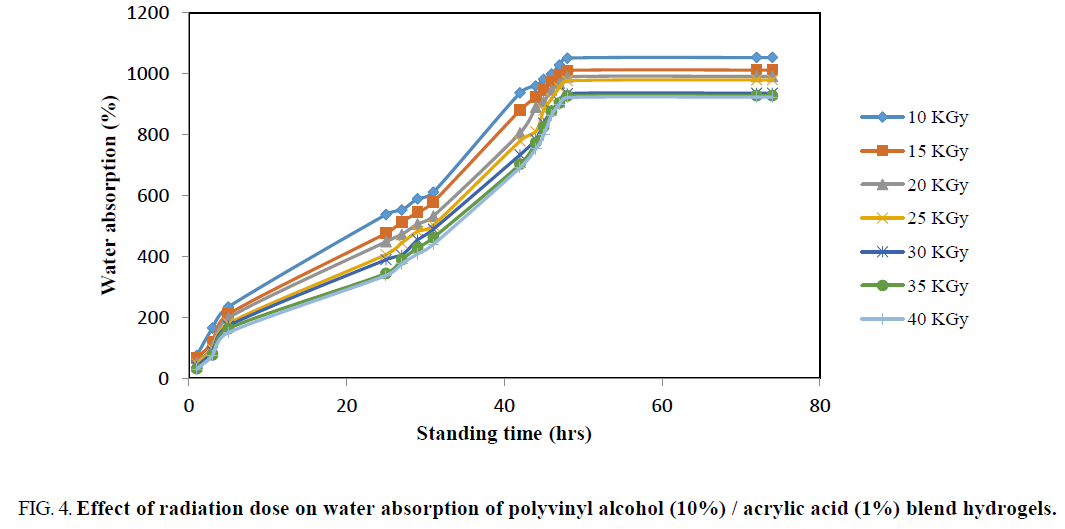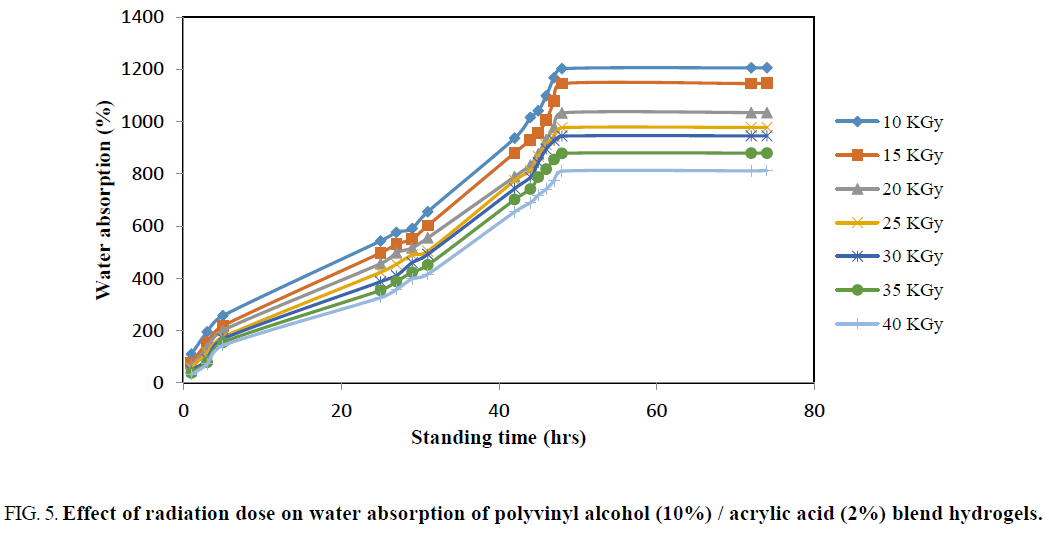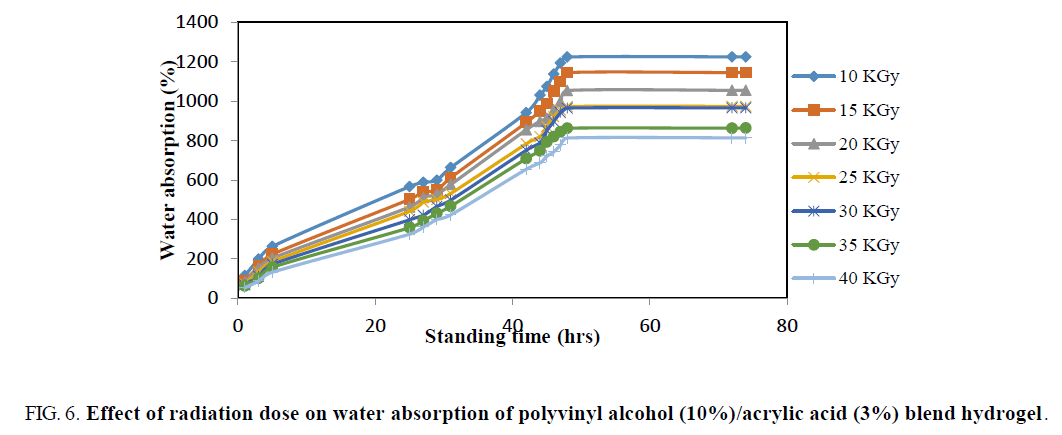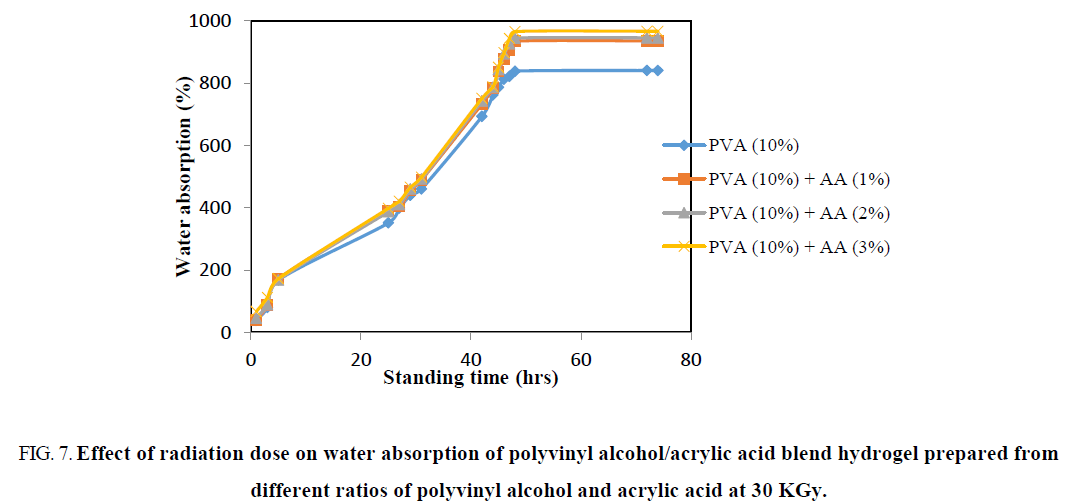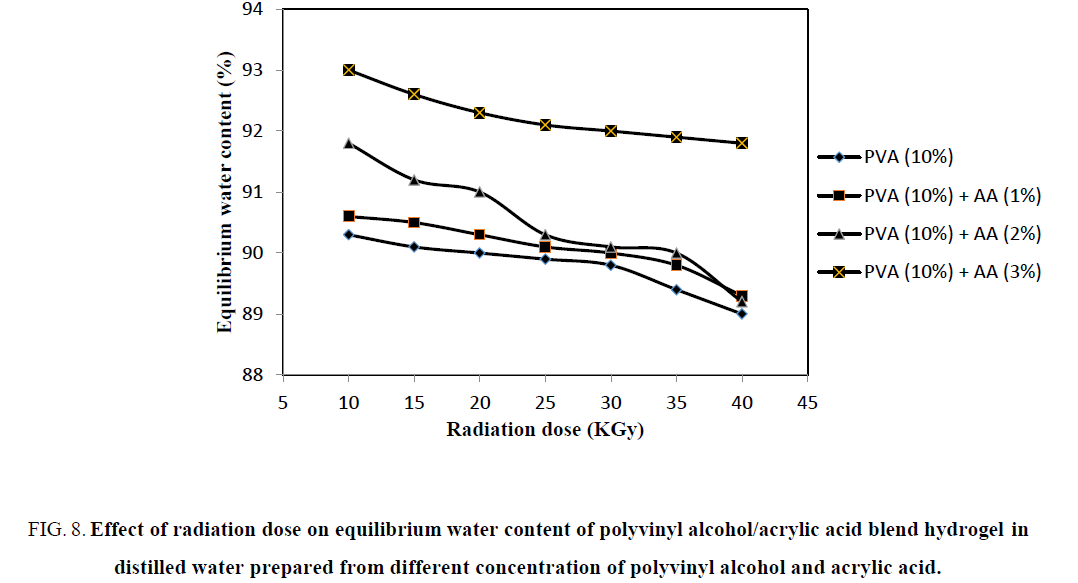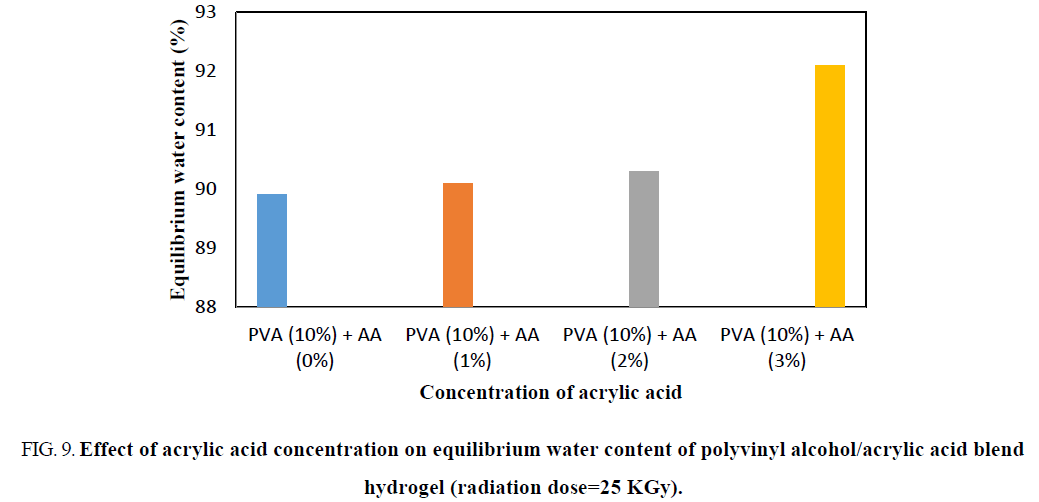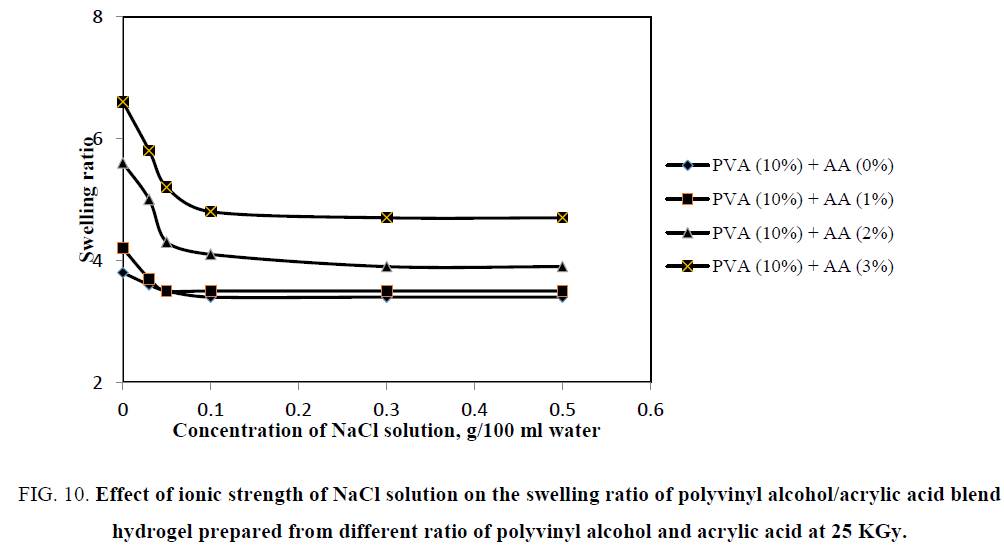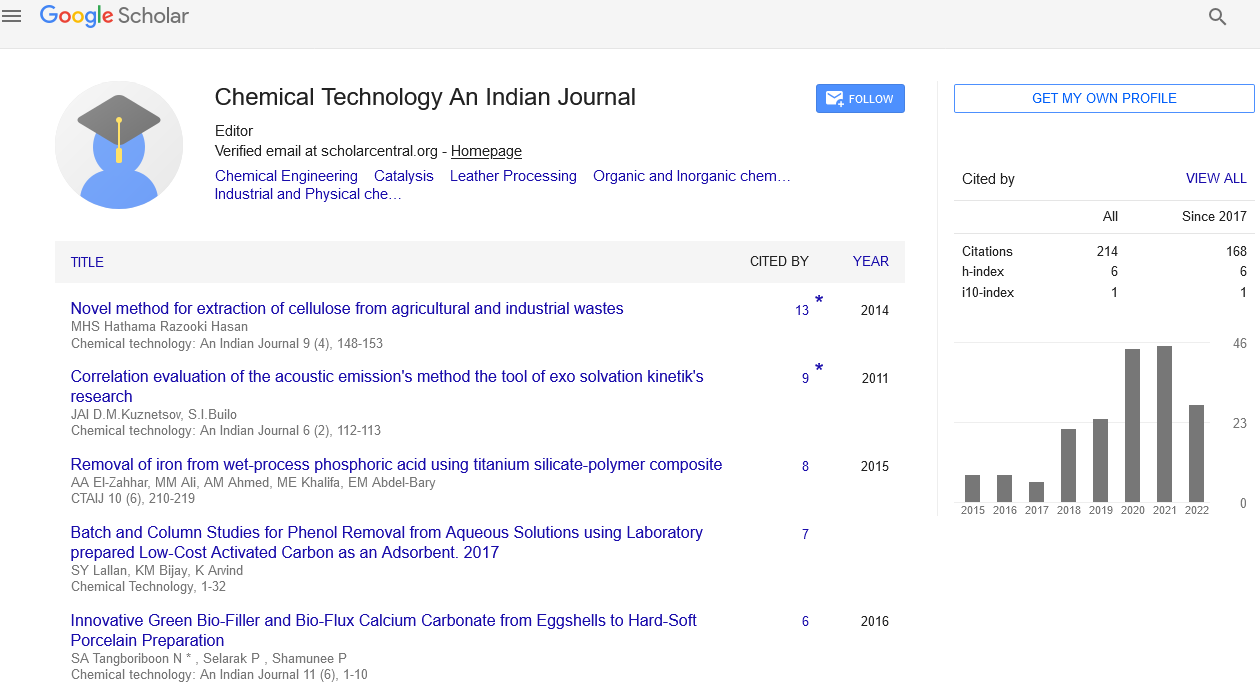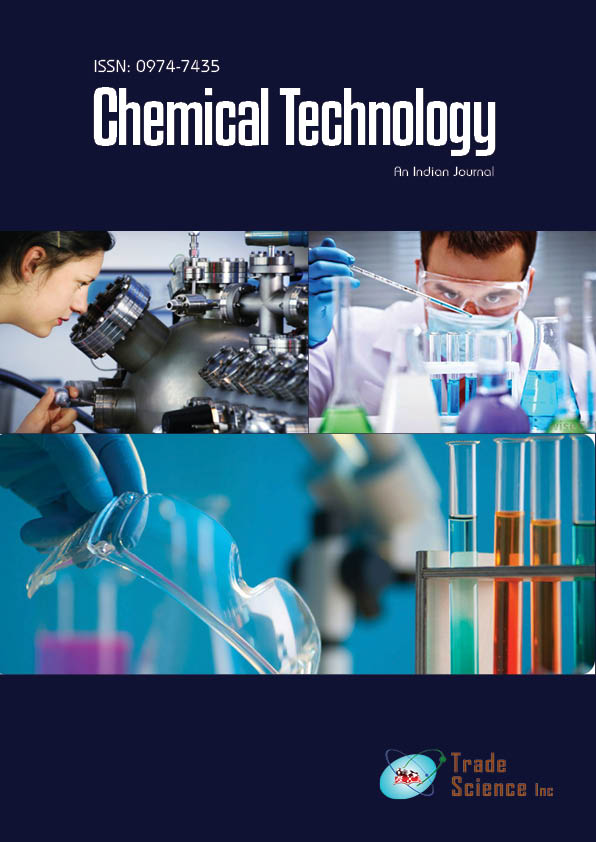Original Article
, Volume: 11( 6)Swelling and Absorption properties of Polyvinyl Alcohol (PVA) and Acrylic Acid Blend Hydrogels: Effect of ó-Irradiation
- *Correspondence:
- Poddar P , Department of Applied Chemistry and Chemical Engineering, Faculty of Engineering, University of Dhaka, Dhaka, Bangladesh,
Tel: 88029661900; E-mail: p.pinku@yahoo.com
Received: September 20, 2016; Accepted: October 21, 2016; Published: November 11, 2016
Citation: Hassan MR, Chowdhury ABMA, Islam MT, et al. γ-Irradiated Polyvinyl Alcohol (PVA) and Acrylic Acid Blend Hydrogels: Swelling and Absorption properties. Chem Technol Ind J. 2016;11(6):107.
Abstract
A series of polyvinyl alcohol and acrylic acid blend hydrogels were prepared in the form of rod by using gamma rays from Co-60 source at room temperature (31°C). The parameters like effect of radiation dose and variation of acrylic acid content in polyvinyl alcohol were studied. The properties like gel fraction, swelling properties (e.g. in water, in NaCl solution of different concentration), water absorption were evaluated. Gel fraction attains a maximum value at the radiation of 25 kGy. After this radiation dose the variation in gel fraction was insignificant. Swelling properties in water decreased with increased radiation dose and increased with increase in the acrylic acid content in the blend gel. Swelling properties also decreased with increased concentration of NaCl in solution. Water absorption attained maximum at 48 h and then the water absorption was insignificant.
Keywords
Polyvinyl alcohol; Acrylic acid; Gel fraction; Hydrogel; Radiation; Swelling properties
Introduction
Hydrogel [1] is a cross linked polymer having three-dimensional network structures that absorbs water and swells to a definite shape [2]. Swelling in water is an inherent property of hydrogel, which imbibes water for the hydrophilic interaction between the networks and water molecules [3]. The hydrophilic character of gel arises due to the presence of polar groups attached to the backbone of network molecule.
The most important and interesting property of hydrogel is the degree of swelling that involves its volume change. This change occurring by solvent sorption with respect to time is strongly responsive on different factors, such as environmental temperature, pH, Ionic Strength, Mechanical stress and so on. The fast response time by hydrogel to reach equilibrium is the key for its successful uses in many applications. These hydrogels have attracted much attention for its potential application in drug delivery devices, artificial muscles, the chemical separation system, sensors and actuator [4,5].
Recently an interest has developed to the hydrophilic polymer gels (hydrogel) as the bio medical materials. Though various techniques arc adopted in preparing hydrogels but radiation crosslinking method has been advantageous over others especially for its approach to clean environment and higher production rate. Various works based on poly vinyl alcohol and acrylic acid hydrogels were performed in the past.
Radiation-sensitive gels were first developed in the 1950s when Day and Stein investigated a color change upon irradiation of a gel containing Folin's phenol. In 1957, Andrews, made measurements the effect of photon and electron beam radiation doses on agar gels. Later studies were done which utilized Fricke solutions and gels. In 1958, Hoecker and Watkins studied an alternative method, which was based on the gamma irradiation-induced polymerization in monomer and polymer solutions.
The importance of hydrogels in biomedical applications was first realized in the late 1950s with the development of poly (2-hydroxyethyl methacrylate) (PHEMA) gels as a soft contact lens material [6]. These PHEMA gels had high water content at equilibrium and exhibited rubbery behavior and good biocompatibility, thus resembling natural tissues more closely than other synthetic materials. After that Rosiak in 1986 invented the first hydrogel membrane for wound dressing processed by radiation in Poland and arrived in the local market in 1992. These were a technological breakthrough. Inspiring from their works, in recent years much works is done on the development and analysis of environmentally responsive hydrogels which makes it applicable in numerous biomedical applications including ophthalmologic devices, biosensors, bio-membranes, and carriers for controlled delivery of drugs or proteins [7-10].
Though various techniques are adopted in preparing hydrogels but radiation cross linking method has been advantageous over other especially for its approach to clean environment and higher production rate. Much of the research has been performed on synthesis and characterization of polyvinyl alcohol and acrylic acid blend hydrogel. However, specific work focusing on optimizing synthesis and characterization of polyvinyl alcohol and acrylic acid blend hydrogel has not been done based on gamma dose, concentration and pH of solvents and time of these parameters to the preparation and characterization of polyvinyl alcohol and acrylic acid blend hydrogels. The most important properties of hydrogel relevant to their biomedical and public health [11,12] applications are also identified, especially for use of hydrogels as drug and cell carriers and as tissues engineering matrixes [13].
Experimental Materials
Polyvinyl alcohol was purchased from BDH Company Ltd, England which purity was 99.5% and Acrylic acid was purchased from Fluka, Switzerland which purity was 97%. Both chemicals were used without any further purification for the preparation of hydrogel. The buffer tablets were purchased from BDH Company Ltd, England. The NaCl used was purchased from Fluka, Switzerland.
Equipments
• Source: Cobalt-60 gamma irradiation is available at the institute of food and radiation biology (IFRB), atomic energy research establishment (AERE), Savar, Dhaka. Specification: Capacity-5000 Ci. BRTI, Mumbai, India.
• Magnetic stirrer with hot plate (Model-78, mode in Great Britain).
• Thermostatic water bath (Made in China).
• Normal Oven (Kasugr E.W.T. Ltd. Japan).
• Electric Pressure Steam Sterilizer (Autoclave).
• Analytical electronic balance (Mattler, Model AE-160-5 range-109 g).
Methodology
In the present work, synthesis of hydrogel from polyvinyl alcohol and acrylic acid by application of gamma radiation source has been thoroughly investigated. Experimental facilities such as chemicals, equipments and experimental procedure for hydrogel preparation are explained below.
Preparation of polyvinyl alcohol/acrylic acid Blend Solution: A 10% polyvinyl alcohol solution was prepared in distilled water. Different quantities of acrylic acid (1, 2 and 3%) were added in aqueous solution of polyvinyl alcohol at 80°C in water bath to get final mixture. The hot mixture was poured in several cylindrical glass vials with diameter of 20 mm, allowed to cool at room temperature and then irradiated at the radiation doses 10 kGy, 15 kGy, 20 kGy, 25 kGy, 30 kGy, 35 kGy and 40 kGy gamma sources at room temperature. The irradiated samples were found in solid state after completion of chemical reaction. At first solution of polyvinyl alcohol were prepared with distilled water and then acrylic acid were mixed with it.
Physical appearance of the samples: After gamma radiation, the physical appearance of the samples is carefully observed and followings are concluded:
• The samples are solid and white looking
• They are odorless
• They are soft at initial time but hard and rigid mass if kept in open air for a long time
• They are slightly elastic
• They are initially adhesive type
• They are slippery
Measurement of gel content: About 0.4 g to 0.6 g of all irradiated samples were first air dried for about 10-12 h. Then they were dried to have a constant weight in an oven at 60°C. Then the samples were kept in distilled water for 24 h to remove soluble part of samples were again dried for constant weight. The extracted samples were then oven dried t i l l constant weight. The gel content was determined gravimetrically as;

Where Wg is the weight of dry gel after extraction in water and Wi is the initial weight of dry gel.
Determination of swelling ratio in distilled water: First about 0.4 g to 0.6 g irradiated samples was oven dried. Then the sols were extracted by swelling the sample in distilled water at room temperature for 24 h. Then the sample was again oven dried to constant weight (W1) and then dipped in distilled water for 24 h at room temperature. Then the sample were unwrapped from the water, surface water was removed gently by tissue paper and weighted (W2). The swelling ratio than calculated as:

Determination of swelling ratio in NaCl solution: First about 0.4 g to 0.6 g irradiated. Sample was oven dried Then the sols were extracted by swelling the sample in distilled water at room temperature for 24 h. Then the sample was again oven dried to constant weight (W1) and dipped in NaCl solution having different concentration for 24 h at room temperature. After un-wrapping the sample from NaCl solution, the swelled sample was weighted after removing adhering water. The swelling is calculated as:

Determination of swelling ratio in NaCl solution: First about 0.4 g to 0.6 g irradiated. Sample was oven dried Then the sols were extracted by swelling the sample in distilled water at room temperature for 24 h. Then the sample was again oven dried to constant weight (W1) and dipped in NaCl solution having different concentration for 24 h at room temperature. After un-wrapping the sample from NaCl solution, the swelled sample was weighted after removing adhering water. The swelling is calculated as:

Determination of equilibrium water content (EWC): Equilibrium water content (EWC) was calculated as:

Where,
W1=Weight of swollen gel at equilibrium.
W0=Initial weight of dry sample.
Results and Discussion
Gel fraction
Gel is an insoluble part of a cross-link polymer network and measured after removing sol part (soluble portion) in a suitable solvent. Gel fraction of the sample increase with the increase of radiation dose. As the radiation dose passing through a monomer/polymer system, the concentration of the free radicals in the monomer/polymer system increases. It is known that, the free radical is responsible for cross-linking so with the increase of radiation dose the cross-linking among polymer chains resulting an increase in gel fraction. Figure 1. Shows the effect of radiation dose and the concentration of acrylic acid in polyvinyl alcohol aqueous solution on the gel fraction of polyvinyl alcohol/acrylic acid blend hydrogel. It is found that gel fraction increases with increased radiation dose and attains maximum at the radiation dose of 25 kGy. After this radiation dose the variation of gel fraction is almost unchanged. It is also found that gel fraction depends on the content of acrylic acid in the mixture of polyvinyl alcohol and acrylic acid solution. Gel fraction decrease with increasing of acrylic acid concentration in the mixture of polyvinyl alcohol and acrylic acid solution.
Figure 1: Effect of radiation dose on gel fraction of polyvinyl alcohol/acrylic acid blend hydrogel.
Swelling ratio in distilled water
Swelling is a result of balance of two forces. One is osmotic force and other is dispersing force. Osmotic force pushes water into polymer network whereas dispersing force exerted by the polymer chain resist it. Increase in cross-linked density enhances the dispersing force. Figure 2 shows the effect of different dose on swelling ratio of different types of polyvinyl alcohol/acrylic acid blend hydrogels. The result indicates that as the swelling ratio decreases with increased radiation doses. The decreasing trend of swelling ratio is fast up to 25 kGy radiation dose. After this radiation dose, it becomes slow. It is also found that swelling ratio depends on acrylic acid content in blend hydrogel. Swelling ratio is higher with higher content of acrylic acid in the blend hydrogel. The result is explained by increased the acrylic acid content in blend hydrogel, the hydrophilic group increases. As results ratios of blend hydrogel increases with increased acrylic acid content.
Figure 2: Effect of radiation dose on swelling ratio (after 24 hours) of different concentration of polyvinyl alcohol/acrylic acid blend hydrogel.
Water absorption (%)
Figure 3 represent the effect the radiation dose on the water absorption of polyvinyl alcohol hydrogel prepared from 10% solution of polyvinyl alcohol. From the figure, it is found that the maximum absorption of water occurs within 48 h. After that the absorption of water is insignificant. It is also found that the increase of radiation dose the percent of water absorption decrease.
Figure 4 represents the effect the radiation dose on the water absorption of polyvinyl alcohol/acrylic acid blend hydrogel prepared from 10% solution of polyvinyl alcohol and 1% solution of acrylic acid mixture, Figure 5 represents the effect the radiation dose on the water absorption of polyvinyl alcohol/acrylic acid blend hydrogel prepared from 10% solution of polyvinyl alcohol and 2% solution of acrylic acid mixture, Figure 6 represents the effect the radiation dose on the water absorption of polyvinyl alcohol/acrylic acid blend hydrogel prepared from 10% solution of polyvinyl alcohol and 3% solution of acrylic acid mixture. From all of three figures it is found that the maximum absorption of water occurs within 48 h. After that the absorption of water is insignificant. It is also found that the increases of radiation dose the percent of water absorption decrease.
Figure 4: Effect of radiation dose on water absorption of polyvinyl alcohol (10%) / acrylic acid (1%) blend hydrogels.
Figure 5: Effect of radiation dose on water absorption of polyvinyl alcohol (10%) / acrylic acid (2%) blend hydrogels.
Figure 6: Effect of radiation dose on water absorption of polyvinyl alcohol (10%)/acrylic acid (3%) blend hydrogel.
Figure 7 represents the effect the radiation dose on the water absorption of polyvinyl alcohol/acrylic acid blend hydrogel prepared from 10% solution of polyvinyl alcohol and different concentration of acrylic acid in the blend gel. As the concentration of blend hydrogel increase such as acrylic acid concentration increase and therefore, rate of absorption increase. This polymer degraded by the action of radiation. The degraded acrylic acid molecules may be entrapped/interacted with polyvinyl alcohol. The water absorption capacity of acrylic acid molecule is high due to the presence of carboxylic group in it. As a result, the swelling ratio increases with increase in concentration of acrylic acid in PVA/AA blend hydrogel.
Figure 7: Effect of radiation dose on water absorption of polyvinyl alcohol/acrylic acid blend hydrogel prepared from different ratios of polyvinyl alcohol and acrylic acid at 30 KGy.
It is evident that the swelling process is faster initially and after 6 hours water absorption increases but slowly. It explains the hydrophilic character of the gel. Initially attraction of the gel to water was higher, this is why hydration rate was faster at the beginning. After sometime the gel was around saturated so absorption rate decrease. From the figure, it is found that the maximum absorption of water occurs within 48 h. After that the absorption of water is insignificant. It is also found that the increase of radiation dose the percent of water absorption decease.
Equilibrium water content (Ewc)
Figure 8 and 9 shows the variation of Ewc of polyvinyl alcohol/acrylic acid blend hydrogels in varying quantities of acrylic acid. The values of Ewc increase with increase in quantities of acrylic acid content in the hydrogels. It increases from ~89% to 93% for the concentration of acrylic acid in the range 1% to 3% in the hydrogels. Acrylic acid has high affinity to water due to presence of -COOH group in it as a result Ewc of polyvinyl alcohol/acrylic acid hydrogels increases. Carboxymethyl cellulose (CMC) improves swelling properties of poly (vinyl alcohol)/sago blend hydrogel due to the presence of the carboxylic group in the CMC molecules.
Figure 8: Effect of radiation dose on equilibrium water content of polyvinyl alcohol/acrylic acid blend hydrogel in distilled water prepared from different concentration of polyvinyl alcohol and acrylic acid.
Figure 9: Effect of acrylic acid concentration on equilibrium water content of polyvinyl alcohol/acrylic acid blend hydrogel (radiation dose=25 KGy).
Swelling ratio in NaCl Solution
Figure 10 shows the effect of sodium chloride concentration in swelling medium (water) on swelling ratio of polyvinyl alcohol/acrylic acid blend hydrogel prepared at 25 kGy radiation dose. It is found that increased ionic strength in solution leads to decrease in swelling ratio of the hydrogel. This characteristic can be explained on the basis of osmotic pressure developed due to unequal distribution of ions in the medium and polymer networks. When the hydrogels are immersed in water, there is maximum osmotic pressure developed and hence the maximum swelling is obtained. When the hydrogel is kept in sodium chloride solution the osmotic pressure developed is much lower due to the external solution contains Na+ and Cl-. So swelling is reduced in significantly.
Figure 10: Effect of acrylic acid concentration on equilibrium water content of polyvinyl alcohol/acrylic acid blend hydrogel (radiation dose=25 KGy).
Conclusion
Polyvinyl alcohol/acrylic acid blend hydrogel was prepared from different ratios of acrylic acid using gamma irradiation at different dose (e.g., 10 kGy, 15 kGy, 20 kGy, 25 kGy, 30 kGy, 35 kGy and 40 kGy). From this investigation it can be concluded that the optimum radiation dose for the preparation of polyvinyl alcohol/acrylic acid blend hydrogel is 25 kGy. Polyvinyl alcohol is polymerized and cross-linked when it is subjected to radiation. The increase of acrylic acid ratio in the blend gel decreased the gel fraction and vice versa. The swelling ratio of polyvinyl alcohol/acrylic acid blend hydrogel in distilled water, in NaCl solution increases with the increased content of acrylic acid. The absorption of water attained maximum value within 48 h of experiment.
References
- Gulenoor F, Poddar P, Islam BMT, et al. γ-Irradiated Polyvinyl Alcohol (PVA) and Citric acid blend Hydrogels: Swelling and Absorption properties. Chem. Sci.. 2016;7(2):125.
- Park K, Park H. Encyclopedia of polymer science and technology. 1996;10:7785.
- Bawn CSH. Encyclopedia of polymer science and engineering. Polymer. 1987;28(7):1234.
- Kope?ek J, Rejmanova P. Enzymatically Degradable Bonds in Synthetic Polymers. In: Bruck SD editor. Controlled Drug Delivery. 1983:81-124.
- Gehrke SH. Advances in polymer science. Responsive gels. 1993;11:110.
- Wichterle O, Lim D. Hydrophilic gels for biological use. Nature. 1960;185:117-8.
- Lowman AM, Peppas NA. Hydrogels in Encyclopedia of controlled drug delivery. MathiowitzE, editor. 1999;397-418.
- Huglin MR. Hydrogels in medicine and pharmacy. Peppas NA, editor. CRC Press Inc. Boca Raton:Florida;1987.
- Andrade JD. Hydrogels for Medical and Related Applications, Copyright, ACS Symposium Series, FOREWORD. Gould RF, editor. Hydrogels for medical and related applications. Am Chem Soc. 31:1976.
- Peppas NA, Hung Y, Torres-Lugo M, et al. Physiomedical foundations and structural design of hydrogels in medicine and biology. Annua Rev Biomed. 2000;2:19-29.
- Islam MdT, Dafader NC, Poddar P, et al. Studies on Swelling and Absorption Properties of the γ-Irradiated Polyvinyl Alcohol (PVA)/ Kappa-Carrageenan Blend Hydrogels. J Adv Chem Eng. 2016;6(2):2090-4568.
- Dafader NC, Manir MS, Alam MF, et al. Effect of kappa-carrageenan on the properties of poly(vinyl alcohol) hydrogel prepared by application of gamma radiation. SOP Transactions on Applied Chemistry 2. 2015;1-12.
- Hoffman AS. Hydrogels for biomedical applications. Bio Engineering department, University of Washington reviews. 2002;54(1):3-12.
